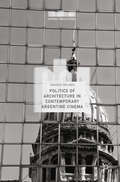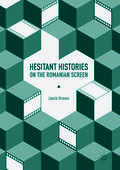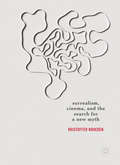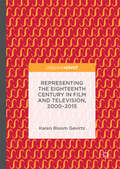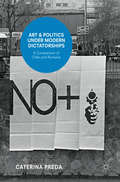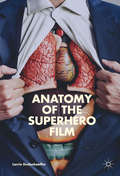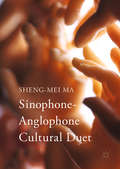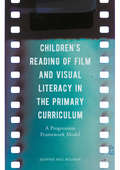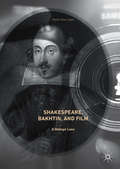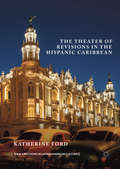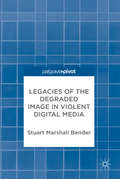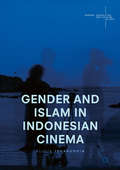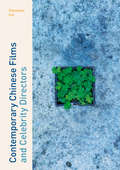- Table View
- List View
Politics of Architecture in Contemporary Argentine Cinema
by Amanda HolmesThis book considers how architectural landmarks, imagined buildings and urban landscapes take part in the production of meaning in contemporary Argentine cinema. From the iconic Buenos Aires Obelisk to the Hilton International Hotel, the shopping center to the café and the Le Corbusier-designed Curutchet House to the gated community, architecture in these films evokes the political. Tracing architecture’s expression through six films produced since the 1990s—Pizza birra faso, Mundo grúa, Nueve reinas, La niña santa, La antena and El hombre de al lado—Amanda Holmes studies how architecture in cinema elicits political memory, underscores marginalization and class discrepancies, creates nostalgia for neighborhoods and re-evaluates existing communities. Generously illustrated and carefully researched, the book offers an in-depth reading of key contemporary Argentine films and a fresh architectural approach to film analysis.
Politics of Architecture in Contemporary Argentine Cinema
by Amanda HolmesThis book considers how architectural landmarks, imagined buildings and urban landscapes take part in the production of meaning in contemporary Argentine cinema. From the iconic Buenos Aires Obelisk to the Hilton International Hotel, the shopping center to the café and the Le Corbusier-designed Curutchet House to the gated community, architecture in these films evokes the political. Tracing architecture’s expression through six films produced since the 1990s—Pizza birra faso, Mundo grúa, Nueve reinas, La niña santa, La antena and El hombre de al lado—Amanda Holmes studies how architecture in cinema elicits political memory, underscores marginalization and class discrepancies, creates nostalgia for neighborhoods and re-evaluates existing communities. Generously illustrated and carefully researched, the book offers an in-depth reading of key contemporary Argentine films and a fresh architectural approach to film analysis.
Hesitant Histories on the Romanian Screen
by László StrauszThis book argues that hesitation as an artistic and spectatorial strategy connects various screen media texts produced in post-war Romania. The chapters draw a historical connection between films made during the state socialist decades, televised broadcasts of the 1989 Romanian revolution, and films of the new Romanian cinema. The book explores how the critical attitude of new Romanian cinema demonstrates a refusal to accept limiting, binary discourses rooted in Cold War narratives. Strausz argues that hesitation becomes an attempt to overcome restrictive populist narratives of the past and present day. By employing a performative and mobile position, audiences are encouraged to consider conflicting approaches to history and social transformation.
Hesitant Histories on the Romanian Screen
by László StrauszThis book argues that hesitation as an artistic and spectatorial strategy connects various screen media texts produced in post-war Romania. The chapters draw a historical connection between films made during the state socialist decades, televised broadcasts of the 1989 Romanian revolution, and films of the new Romanian cinema. The book explores how the critical attitude of new Romanian cinema demonstrates a refusal to accept limiting, binary discourses rooted in Cold War narratives. Strausz argues that hesitation becomes an attempt to overcome restrictive populist narratives of the past and present day. By employing a performative and mobile position, audiences are encouraged to consider conflicting approaches to history and social transformation.
Surrealism, Cinema, and the Search for a New Myth
by Kristoffer NohedenThis book examines post-war surrealist cinema in relation to surrealism’s change in direction towards myth and magic following World War II. Intermedial and interdisciplinary, the book unites cinema studies with art history and the study of Western esotericism, closely engaging with a wide range of primary sources, including surrealist journals, art, exhibitions, and writings. Kristoffer Noheden looks to the Danish surrealist artist Wilhelm Freddie’s forays into the experimental short film, the French poet Benjamin Péret’s contribution to the documentary film L’Invention du monde, the Argentinean-born filmmaker Nelly Kaplan’s feature films, and the Czech animator Jan Svankmajer’s work in short and feature films. The book traces a continuous engagement with myth and magic throughout these films, uncovering a previously unknown strain of occult imagery in surrealist cinema. It broadens the scope of the study of not only surrealist cinema, but of surrealism across the art forms. Surrealism, Cinema, and the Search for a New Myth will appeal to film scholars, art historians, and those interested in the impact of occultism on modern culture, film, and the arts.
Surrealism, Cinema, and the Search for a New Myth
by Kristoffer NohedenThis book examines post-war surrealist cinema in relation to surrealism’s change in direction towards myth and magic following World War II. Intermedial and interdisciplinary, the book unites cinema studies with art history and the study of Western esotericism, closely engaging with a wide range of primary sources, including surrealist journals, art, exhibitions, and writings. Kristoffer Noheden looks to the Danish surrealist artist Wilhelm Freddie’s forays into the experimental short film, the French poet Benjamin Péret’s contribution to the documentary film L’Invention du monde, the Argentinean-born filmmaker Nelly Kaplan’s feature films, and the Czech animator Jan Svankmajer’s work in short and feature films. The book traces a continuous engagement with myth and magic throughout these films, uncovering a previously unknown strain of occult imagery in surrealist cinema. It broadens the scope of the study of not only surrealist cinema, but of surrealism across the art forms. Surrealism, Cinema, and the Search for a New Myth will appeal to film scholars, art historians, and those interested in the impact of occultism on modern culture, film, and the arts.
Representing the Eighteenth Century in Film and Television, 2000–2015
by Karen Bloom GevirtzThis book analyzes early twenty-first century film and television’s fascination with representing the Anglo-American eighteenth century. Grounded in cultural studies, film studies, and adaptation theory, the book examines how these works represented the eighteenth century to assuage anxieties about values, systems, and institutions at the start of a new millennium. The first two chapters reveal how films like Gulliver’s Travels (2010) or the remake of Poldark (2015) use history to establish the direct relationship between the eighteenth century and the twenty-first. The final chapters examine pairs of productions for how they address and legitimate different aspects of contemporary ideology such as attitudes toward race and gender, or the connection between technological and social progress.
Representing the Eighteenth Century in Film and Television, 2000–2015
by Karen Bloom GevirtzThis book analyzes early twenty-first century film and television’s fascination with representing the Anglo-American eighteenth century. Grounded in cultural studies, film studies, and adaptation theory, the book examines how these works represented the eighteenth century to assuage anxieties about values, systems, and institutions at the start of a new millennium. The first two chapters reveal how films like Gulliver’s Travels (2010) or the remake of Poldark (2015) use history to establish the direct relationship between the eighteenth century and the twenty-first. The final chapters examine pairs of productions for how they address and legitimate different aspects of contemporary ideology such as attitudes toward race and gender, or the connection between technological and social progress.
Art and Politics under Modern Dictatorships: A Comparison of Chile and Romania
by Caterina PredaThis book analyzes the relationship between art and politics in two contrasting modern dictatorships. Through a detailed look at the Chilean and Romanian dictatorships, it compares the different ways in which political regimes convey their view of the world through artistic means. It examines how artists help \ convey a new understanding of politics and political action during repressive regimes that are inspired by either communism or anti-communism (neoliberalism, traditionalist, conservative). This book demonstrates how artistic renderings of life during dictatorships are similar in more than one respect, and how art can help better grasp the similarities of these regimes. It reveals how dictatorships use art to symbolically construct their power, which artists can consolidate by lending their support, or deconstruct through different forms of artistic resistance.
Art and Politics under Modern Dictatorships: A Comparison of Chile and Romania
by Caterina PredaThis book analyzes the relationship between art and politics in two contrasting modern dictatorships. Through a detailed look at the Chilean and Romanian dictatorships, it compares the different ways in which political regimes convey their view of the world through artistic means. It examines how artists help \ convey a new understanding of politics and political action during repressive regimes that are inspired by either communism or anti-communism (neoliberalism, traditionalist, conservative). This book demonstrates how artistic renderings of life during dictatorships are similar in more than one respect, and how art can help better grasp the similarities of these regimes. It reveals how dictatorships use art to symbolically construct their power, which artists can consolidate by lending their support, or deconstruct through different forms of artistic resistance.
Anatomy of the Superhero Film
by Larrie DudenhoefferThis book addresses what a superhero body can do by developing several “x-rays” of the superbody’s sensoria, anatomic structures, internal systems, cellular organizations, and orthotic, chemical, or technological enhancements. In short, these x-rays offer what we might describe as a metamorpho-physiological approach to the superheroes in feature films, theatrical cartoon shorts, and Netflix television series. This approach examines the ways in which the “substance” of superheroes, which includes their masks, costumes, chevrons, weapons, and auras, extends into the diegetic environment of the film, transgressing it, transforming it, and corporealizing it, making it emblematic of the shape, dimensions, contours, and organismic workings of one or more of our major organs, members, orifices, fluids, or cell clusters. Thus the superhero film, as this study claims, works to make us more aware of the mutability, adaptability, modifiability, and virtual capabilities of our own flesh.
Anatomy of the Superhero Film
by Larrie DudenhoefferThis book addresses what a superhero body can do by developing several “x-rays” of the superbody’s sensoria, anatomic structures, internal systems, cellular organizations, and orthotic, chemical, or technological enhancements. In short, these x-rays offer what we might describe as a metamorpho-physiological approach to the superheroes in feature films, theatrical cartoon shorts, and Netflix television series. This approach examines the ways in which the “substance” of superheroes, which includes their masks, costumes, chevrons, weapons, and auras, extends into the diegetic environment of the film, transgressing it, transforming it, and corporealizing it, making it emblematic of the shape, dimensions, contours, and organismic workings of one or more of our major organs, members, orifices, fluids, or cell clusters. Thus the superhero film, as this study claims, works to make us more aware of the mutability, adaptability, modifiability, and virtual capabilities of our own flesh.
Sinophone-Anglophone Cultural Duet
by Sheng-Mei MaThis book examines the paradox of China and the United States’ literary and visual relationships, morphing between a happy duet and a contentious duel in fiction, film, poetry, comics, and opera from both sides of the Pacific. In the 21st century where tension between the two superpowers escalates, a gaping lacuna lies in the cultural sphere of Sino-Anglo comparative cultures. By focusing on a “Sinophone-Anglophone” relationship rather than a “China-US” one, Sheng-mei Ma eschews realpolitik, focusing on the two languages and the cross-cultural spheres where, contrary to Kipling’s twain, East and West forever meet, like a repetition compulsion bordering on neurosis over the self and its cultural other. Indeed, the coupling of the two—duet-cum-duel—is so predictable that each seems attracted to and repulsed by its dark half, semblable, (in)compatible for their shared larger-than-life-ness.
Sinophone-Anglophone Cultural Duet
by Sheng-Mei MaThis book examines the paradox of China and the United States’ literary and visual relationships, morphing between a happy duet and a contentious duel in fiction, film, poetry, comics, and opera from both sides of the Pacific. In the 21st century where tension between the two superpowers escalates, a gaping lacuna lies in the cultural sphere of Sino-Anglo comparative cultures. By focusing on a “Sinophone-Anglophone” relationship rather than a “China-US” one, Sheng-mei Ma eschews realpolitik, focusing on the two languages and the cross-cultural spheres where, contrary to Kipling’s twain, East and West forever meet, like a repetition compulsion bordering on neurosis over the self and its cultural other. Indeed, the coupling of the two—duet-cum-duel—is so predictable that each seems attracted to and repulsed by its dark half, semblable, (in)compatible for their shared larger-than-life-ness.
Children's Reading of Film and Visual Literacy in the Primary Curriculum: A Progression Framework Model
by Jeannie Hill BulmanThis book draws on a longitudinal study which highlights the beneficial impact of film in the primary curriculum. It provides detailed accounts of both the reading process as understood within the field of literacy education, and of film theory as it relates to issues such as narration, genre and audience. The book focuses on a small cohort of children to explore how progression in reading film develops throughout a child’s time in Key Stage 2; it also examines how the skills and understanding required to read film can support the reading of print, and vice versa, in an ‘asset model’ approach. Since children’s progression in reading film is found to be not necessarily age-related, but rather built on a period of experience and opportunity to read and/or create moving image media, Bulman clearly illustrates the importance of the inclusion of film in the primary curriculum. The book provides an accessible study to a large audience of primary teachers and practitioners, and will be a valuable resource for students and researchers in the fields of education, English and media studies.
Children's Reading of Film and Visual Literacy in the Primary Curriculum: A Progression Framework Model
by Jeannie Hill BulmanThis book draws on a longitudinal study which highlights the beneficial impact of film in the primary curriculum. It provides detailed accounts of both the reading process as understood within the field of literacy education, and of film theory as it relates to issues such as narration, genre and audience. The book focuses on a small cohort of children to explore how progression in reading film develops throughout a child’s time in Key Stage 2; it also examines how the skills and understanding required to read film can support the reading of print, and vice versa, in an ‘asset model’ approach. Since children’s progression in reading film is found to be not necessarily age-related, but rather built on a period of experience and opportunity to read and/or create moving image media, Bulman clearly illustrates the importance of the inclusion of film in the primary curriculum. The book provides an accessible study to a large audience of primary teachers and practitioners, and will be a valuable resource for students and researchers in the fields of education, English and media studies.
Shakespeare, Bakhtin, and Film: A Dialogic Lens
by Keith HarrisonThis book explores how Bakhtin’s ideas can illuminate the compelling but uneasy fusion of Shakespeare and cinema. With a wide variety of tones, languages, cultural orientations, and thematic concerns, film directors have updated, translated, transposed, fragmented, parodied, and geographically re-situated Shakespeare. Keith Harrison illustrates how Bakhtin’s interlinked writings in various fields can fruitfully be applied to an understanding of how the ongoing responsiveness of filmmakers to Shakespeare’s historically remote words can shape self-expressive acts of co-authoring in another medium. Through the use of such Bakhtinian concepts as the chronotope, heteroglossia, the carnivalesque, and polyphony, Harrison details how filmmakers—faithful to their specific cultures, genders, geographies, and historical moments—dialogically locate their particularity through Shakespeare’s presence.
The Theater of Revisions in the Hispanic Caribbean
by Katherine FordThis book explores the textured process of rewriting and revising theatrical works in the Spanish-speaking Caribbean as both a material and metaphorical practice. Deftly tracing these themes through community theater groups, ancient Greek theater, religious traditions, and national historical events, Katherine Ford weaves script, performance and final product together with an eye to the social significance of revision. Ultimately, to rewrite and revise is to re-envision and re-imagine stage practices in the twentieth-century Hispanic Caribbean.
The Theater of Revisions in the Hispanic Caribbean
by Katherine FordThis book explores the textured process of rewriting and revising theatrical works in the Spanish-speaking Caribbean as both a material and metaphorical practice. Deftly tracing these themes through community theater groups, ancient Greek theater, religious traditions, and national historical events, Katherine Ford weaves script, performance and final product together with an eye to the social significance of revision. Ultimately, to rewrite and revise is to re-envision and re-imagine stage practices in the twentieth-century Hispanic Caribbean.
Legacies of the Degraded Image in Violent Digital Media
by Stuart Marshall BenderThis book undertakes a concentrated study of the impact of degraded and low-quality imagery in contemporary cinema and real-world portrayals of violence. Through a series of case studies, the book explores examples of corrupted digital imagery that range from mainstream cinema portrayals of drone warfare and infantry killing, through to real-world recordings of terrorist attacks and executions, as well as perpetrator-created murder videos live-streamed on the internet. Despite post-modernist concerns of cultural inurement during the seminal period of digitalized and virtualized killing in the 1990s, real-world reactions to violent media indicate that our culture is anything but desensitized to these media depictions. Against such a background, this book is a concentrated study of how these images are created and circulated in the contemporary media landscape and how the effect and affect of violent material is impacted by the low-resolution aesthetic.
Legacies of the Degraded Image in Violent Digital Media
by Stuart Marshall BenderThis book undertakes a concentrated study of the impact of degraded and low-quality imagery in contemporary cinema and real-world portrayals of violence. Through a series of case studies, the book explores examples of corrupted digital imagery that range from mainstream cinema portrayals of drone warfare and infantry killing, through to real-world recordings of terrorist attacks and executions, as well as perpetrator-created murder videos live-streamed on the internet. Despite post-modernist concerns of cultural inurement during the seminal period of digitalized and virtualized killing in the 1990s, real-world reactions to violent media indicate that our culture is anything but desensitized to these media depictions. Against such a background, this book is a concentrated study of how these images are created and circulated in the contemporary media landscape and how the effect and affect of violent material is impacted by the low-resolution aesthetic.
Gender and Islam in Indonesian Cinema
by Alicia IzharuddinThis book presents a historical overview of the Indonesian film industry, the relationship between censorship and representation, and the rise of Islamic popular culture. It considers scholarship on gender in Indonesian cinema through the lens of power relations. With key themes such as nationalism, women's rights, polygamy, and terrorism which have preoccupied local filmmakers for decades, Indonesia cinema resonates with the socio-political changes and upheavals in Indonesia’s modern history and projects images of the nation through the debates on gender and Islam. The text also sheds light on broader debates and questions about contemporary Islam and gender construction in contemporary Indonesia. Offering cutting edge accounts of the production of Islamic cinema, this new book considers gendered dimensions of Islamic media creation which further enrich the representations of the 'religious' and the 'Islamic' in the everyday lives of Muslims in South East Asia.
Gender and Islam in Indonesian Cinema
by Alicia IzharuddinThis book presents a historical overview of the Indonesian film industry, the relationship between censorship and representation, and the rise of Islamic popular culture. It considers scholarship on gender in Indonesian cinema through the lens of power relations. With key themes such as nationalism, women's rights, polygamy, and terrorism which have preoccupied local filmmakers for decades, Indonesia cinema resonates with the socio-political changes and upheavals in Indonesia’s modern history and projects images of the nation through the debates on gender and Islam. The text also sheds light on broader debates and questions about contemporary Islam and gender construction in contemporary Indonesia. Offering cutting edge accounts of the production of Islamic cinema, this new book considers gendered dimensions of Islamic media creation which further enrich the representations of the 'religious' and the 'Islamic' in the everyday lives of Muslims in South East Asia.
Contemporary Chinese Films and Celebrity Directors
by Shenshen CaiThis new text examines recent popular Chinese films and derivative cultural phenomena, with a focus on films directed by celebrity directors such as Han Han, Guo Jingming, Xu Jinglei and Zhao Wei. In opposition to Fifth and Sixth Generation Chinese filmmakers who explored the grand-narratives of history, the oppression of the pre-socialist and socialist eras, and those marginalized by socio-economic changes, the celebrity directors at the heart of this book center on the new trends of living and emotional challenges faced by contemporary Chinese people, in particular the younger generations. This book sheds light on newly emerging social and cultural fashions in contemporary China, such as the social stigma of being ‘left-over’ (reflected in Xu Jinglei’s films), the issue of wealth ‘flaunting’ (represented in Guo Jingming’s films) or nostalgia for the long lost innocence of adolescence (demonstrated in Zhao Wei’s film). Considering present-day consumer capitalism through the lens of cinema, this text analyses in detail the significance of films chosen for their relevance, providing a reflection of social reality and cultural changes in 21st century China.
Contemporary Chinese Films and Celebrity Directors
by Shenshen CaiThis new text examines recent popular Chinese films and derivative cultural phenomena, with a focus on films directed by celebrity directors such as Han Han, Guo Jingming, Xu Jinglei and Zhao Wei. In opposition to Fifth and Sixth Generation Chinese filmmakers who explored the grand-narratives of history, the oppression of the pre-socialist and socialist eras, and those marginalized by socio-economic changes, the celebrity directors at the heart of this book center on the new trends of living and emotional challenges faced by contemporary Chinese people, in particular the younger generations. This book sheds light on newly emerging social and cultural fashions in contemporary China, such as the social stigma of being ‘left-over’ (reflected in Xu Jinglei’s films), the issue of wealth ‘flaunting’ (represented in Guo Jingming’s films) or nostalgia for the long lost innocence of adolescence (demonstrated in Zhao Wei’s film). Considering present-day consumer capitalism through the lens of cinema, this text analyses in detail the significance of films chosen for their relevance, providing a reflection of social reality and cultural changes in 21st century China.
